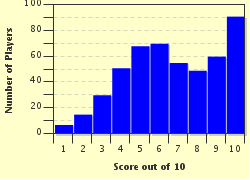Quiz Answer Key and Fun Facts
1. The first few Fibonacci numbers are 0, 1, 1, 2, 3, 5, 8, 13... These numbers are named after Fibonacci, whose real name is?
2. The Fibonacci numbers were first introduced in Fibonacci's book, "Liber abaci" in a question to find the population of an animal at a particular time. What animal did he use?
3. What is the first three-digit square number that appears on the list of Fibonacci numbers?
4. A Fibonacci number is said to be a Fibonacci prime if it is a prime number. For example, 2, 3, 5, 13 and 89. There are only 3 one-digit and 2 two-digit Fibonacci primes. Other examples of Fibonacci primes are 233 and 1597. 233 is the only 3-digit Fibonacci prime and 1597 is also the case for the 4-digits. How many 5-digit Fibonacci prime(s) is/are there?
5. Let F(n) be the function of the Fibonacci numbers, where F(n) is the nth term of the Fibonacci numbers. The limit of F(n+1)/F(n) when n approaches infinity, or the ratios of successive Fibonacci numbers, converges to a well-known constant. Which constant is it?
6. The sum of all of the reciprocals of Fibonacci numbers (excluding 0), which is known as the reciprocal Fibonacci constant was proved to be an irrational number by Richard Andre-Jeannin. This constant's value is? (Hint: Find the sum of the reciprocals for the first few Fibonacci numbers.)
7. Rather than adding up 2 successive numbers, there exists an easier way to find the value of nth term of a Fibonacci number. Suppose that we want to find the value of the 100th Fibonacci number. We just need to replace the value of n with 100 in the equation [phi^n - (1-phi)^n] / surd(5). This formula is known as? (surd means square root of)
8. Which useful number diagram can also be used to generate a list of Fibonacci numbers?
9. The Fibonacci numbers appeared in one of Dan Brown's novels. These numbers were arranged randomly and they were the password to an account that eventually revealed a very important detail that was unknown to mankind. Which novel was it?
10. Fibonacci spirals (generated by drawing a quarter-circle in each box, where a larger box lays adjacent to a smaller one, and the lengths of these boxes are Fibonacci numbers) are claimed to appear in the arrangements and patterns of fruits, vegetables, pine cones, seed heads and shells.
Source: Author
Matthew_07
This quiz was reviewed by FunTrivia editor
crisw before going online.
Any errors found in FunTrivia content are routinely corrected through our feedback system.


